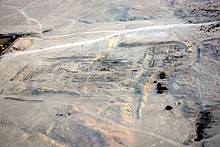Malqata
| Malqata in hieroglyphics | ||||||||||
|---|---|---|---|---|---|---|---|---|---|---|
Pen-tjehen-Aton Pn-ṯḥn-Jtn shine of Aton |
||||||||||
Malqata (alternatively Malkata ) was an ancient Egyptian palace complex on the west bank of the Nile near Thebes (Egypt) .
The palace of Amenhotep III.
This palace was built by Pharaoh Amenhotep III. built and provided with a temple dedicated to his wife Teje and the crocodile deity Sobek . The entire palace was built from adobe bricks . To the east of the palace was a large ceremonial lake, which was connected to the Nile by a system of canals. These canals ended in a large harbor, or wharf, now known as Birket Habu .
There are various structures in the desert where the palace is located. So far, a temple for Amun , a festival hall, rooms for the elite of the empire and the relatives of the royal family, chambers for guards and an altar called Kom al-Samak have been found.
history
The palace was built in the 14th century BC and was called "Per-Hay", which means "house of jubilation", in the time it was inhabited. Originally the palace was known as "Palace of the Shining Aton / Shine of Aton," ( Pn-ṯḥn-Jtn ). It was the residence of the Pharaoh in his later reign. Construction began in his eleventh year of government and was completed about eighteen years later.
Malqata was the main residence of Pharaoh Amenophis III, which was near the capital of the empire at that time, Thebes . Since no palace near and in and around Thebes was as large as this one, it is believed that it was the most important palace in Egypt in ancient times.
However, the palace was not inhabited for very long: his son, Amenophis IV ( Akhenaten ), gave up the residence after he had built the new capital Akhet-Aton in Middle Egypt in honor of the god Aton . When Tutankhamun became king, he returned to the old religion and moved the capital of the country to Memphis . Eje II , the penultimate pharaoh of the 18th dynasty, may have visited the palace again for a short time, as did his successor Haremhab . At the time of Ramses II's reign , Malqata had become a small residence and the capital of the empire was further north.
The entire palace complex was later conquered by the Romans and then by the Byzantines .
structure
The palace included several audience halls , central courtyards and backyards, mansions, smaller complexes for the royal family, and apartments for the employees. A canal and port connected the palace to the Nile, which allowed easy travel to Thebes, which lay on the east bank of the river. There are several finds that prove the existence of such canals and a port.
The complex, which was given to the royal family, consisted of a bedroom, a dressing room, a room for audiences and one for the pharaoh's harem . However, the last room was shortly after Amenhotep III moved in. converted as a storage room. Opposite the room for Amenhotep there were also rooms for children. The palace had a central back courtyard. Teje was given her own area in Malqata, diagonally across from her husband's apartments.
Outside the living quarters there was an extensive garden and a lake suitable for swimming.
There are also remains in the north of the palace that come from an Amun temple. In the south of the palace there is a temple for the deity Isis .
Malqata was ruled by a great number of servants and a staff. The remains of a kitchen and several quarters can be found near the royal apartments. All in all, the palace resembles a small town due to the diversity of residents and spaces.
decoration
The paintings on the walls gave archaeologists an idea of how the palace was decorated. Several paintings of the deity Nechbet can be found on the ceilings of the rulers' bedrooms. Many of the walls were decorated with animal scenes, and flower or swamp landscapes were immortalized on the walls. There were wooden pillars that were also colored to look like oversized flowers. Despite the poor condition of the building, some of these paintings are still recognizable.
Faience decoration
Excavations
The remains of the palace were “rediscovered” several times: in 1888 by Georges Daressy , between 1910 and 1920 by the Metropolitan Museum of Art , by the Museum of the University of Philadelphia in 1970, and since 1985 by Waseda University . A separate altar was also excavated, which was on the outskirts of Malqata.
Malqata today
Today there is a modern village near the ruins of the palace. There is also a small monastery and church called St. Tawdros nearby. The modern Arabic name of the palace translates as "the place where things are kept".
literature
- Iida Kishiro et al. a .: Studies in the palace of Malqata. Investigations at the palace of Malqata 1985-1988 . University Press, Tokyo 1993, ISBN 4-8055-0252-5 (texts in English and Japanese).
Web links
swell
- Waseda University excavations (Kom al-Samak)
- More excavation results, photos
- Minnesota State University e-Museum. Archived from the original on June 1, 2010 ; Retrieved January 19, 2014 .
- Minnesota State University e-Museum. Archived from the original on June 1, 2010 ; Retrieved January 19, 2014 .
Coordinates: 25 ° 42 ′ 55 " N , 32 ° 35 ′ 28" E


